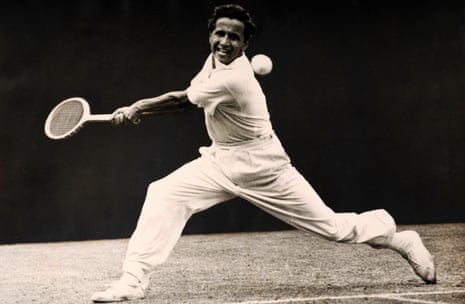The Ecuadorean tennis player Pancho Segura, who has died aged 96, was possibly best known as the coach of Jimmy Connors. However, in his own right he was one of the most remarkable players of his generation.
Segura spent most of his career competing on the outlawed Jack Kramer professional circuit in the 1950s and 60s, before the game went open in 1968. Such was the potency of his double-fisted forehand that two celebrated Wimbledon champions, Kramer and Lew Hoad, had no hesitation in naming the shot as the greatest single stroke they had ever faced.
The miracle was not that Segura played tennis so well but that he played any sport at all. Born prematurely in Guayaquil, Ecuador’s main sea port, he nearly died in the process, and began life with a hernia and malaria. He soon developed rickets, too, which left him with an awkward, pigeon-toed, bandy-legged gait. It also stunted his growth. He was the son of Francisca Cano and her husband, Domingo Segura. Though his father was more than 6ft tall, Pancho never grew past 5ft 7in.
“When I first started playing the States, people said, ‘Who’s that freakish, dark-skinned guy with a double-handed game?’ And it was true. I was a freak,” he recalled. “But that wasn’t going to stop me playing tennis, because I had this passion for the game.”
It was a passion that never died. Having started as a ball boy at the Guayaquil tennis club, Segura played well enough in South American tournaments to get himself to the US on a scholarship in 1940. He won intercollegiate titles (1943-45) as well as becoming the US clay court champion in 1944 and national indoor champion in 1946. That year he also appeared at Wimbledon, losing to a future champion, Jaroslav Drobný. Prior to that he won the London Grasscourt Championships at the Queen’s Club. Soon afterwards he turned pro for $300 a week “because I was broke”.
Even that barely paid his expenses, and Segura frequently played one-off matches for a wager. “We used to tie five-dollar bills to the net because we didn’t trust each other,” said Segura with one of his infectious laughs.
Exposed to relentless competition on the Kramer tour, against a series of champions such as Pancho Gonzalez, Frank Sedgman, Hoad, Ken Rosewall and Tony Trabert, Segura developed into a fierce and dangerous opponent capable of beating anybody on a given night. Only Kramer, who was a playing promoter, and Gonzalez beat him regularly, because of the strength of their second serves.
Segoo, as his friends called him, was a fun-loving, irrepressible presence in locker rooms around the world, whose enthusiasm for the game was unquenchable. Often when the pros returned to home base in Los Angeles after three or four backbreaking weeks on the tour, driving from city to city and playing on hastily rigged canvas courts, they would throw their rackets in a cupboard and prepare for a few days at the beach. But next morning, the phone would ring. “Hey, kid! Wanna hit?” All Segura wanted to do was to get back out on court.
Connors shared that kind of commitment. After Segura had set himself up at the Beverly Hills Tennis Club, he was contacted by Gloria Connors, Jimmy’s mother, who felt that Segura brought the kind of energy and can-do attitude to his tennis that she wanted to instil into her son. “She was right. Jimmy was only 15 when I first started working with him but I enjoyed it because Jimmy never gave up,” said Segura. “He had great mobility and great heart and, despite a strong bond with his mother who brought him up as a player, he was very coachable.”
Connors went on to win eight Grand Slam singles titles and two in men’s doubles between 1973 and 1983: in the much briefer period available to him, Segura got as far as four Grand Slam doubles finals – the men’s at the US (1944) and French (1946), and the US mixed (1943 and 1947). In the US singles, he reached the semi-finals four times (1942-45). The end of his playing career overlapped with the abandonment of the amateur-professional divide, and he left a mark on the first open Wimbledon with the championship’s longest set, 32-30, when he and Alex Olmedo beat Abe Segal and Gordon Forbes. (It was surpassed by the final set, 70-68, of the match between John Isner and Nicolas Mahut in 2010.) But even before he took to coaching full-time, Segura’s advice was sought by leading players.
In 1991 Segura became a US citizen, and in his 80s he was still a regular presence at Grand Slam championships. Sitting next to him at a match was always a slightly precarious way of getting a tennis education. Gesticulating wildly, he would go through the motions of the shot he felt some player should have hit. He was a great admirer of the classic stroke makers such as Roger Federer and Tim Henman: “That Henman has a great game. A little predictable, perhaps, but he does everything with so much class.”
He is survived by his wife, the former Beverley Moylan, and their daughter, Maria; his son, Spencer, from his first marriage, to Virginia Smith, which ended in divorce; his sisters Catalina, Olivera and Eleanor, and brother, Andres; and four grandchildren.
Pancho (Francisco) Olegario Segura Cano, tennis player and coach, born 20 June 1921; died 18 November 2017
- This article was amended on 5 December 2017. Pancho Segura used two hands on his forehand, but not on his backhand. When Gloria Connors first asked him to coach her son Jimmy, he was tennis director at the Beverly Hills Tennis Club rather than the La Costa Spa.

Comments (…)
Sign in or create your Guardian account to join the discussion